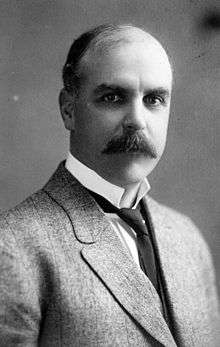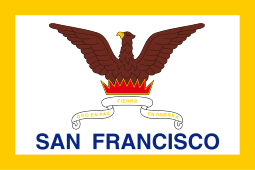James Rolph
James "Sunny Jim" Rolph Jr. (August 23, 1869 – June 2, 1934) was an American politician and a member of the Republican Party. He was elected to a single term as the 27th governor of California from January 6, 1931 until his death on June 2, 1934 at the height of the Great Depression. Previously, Rolph had been the 30th mayor of San Francisco from January 8, 1912 until his resignation to become governor. Rolph remains the longest-serving mayor in San Francisco history.
James Rolph | |
|---|---|
 | |
| 27th Governor of California | |
| In office January 6, 1931 – June 2, 1934 | |
| Lieutenant | Frank Merriam |
| Preceded by | C. C. Young |
| Succeeded by | Frank Merriam |
| Chair of the National Governors Association | |
| In office July 26, 1933 – June 2, 1934 | |
| Preceded by | John Garland Pollard |
| Succeeded by | Paul V. McNutt |
| 30th Mayor of San Francisco | |
| In office January 8, 1912 – January 6, 1931 | |
| Preceded by | P. H. McCarthy |
| Succeeded by | Angelo Rossi |
| Personal details | |
| Born | August 23, 1869 San Francisco, California, U.S. |
| Died | June 2, 1934 (aged 64) Santa Clara County, California, U.S. |
| Political party | Republican |
| Spouse(s) | Annie Marshall Reid |
Life and career
.jpg)
Rolph was born in San Francisco, the son of Margaret (Nicol) and James Rolph.[1][2][3] He had four brothers and two sisters.[4] After attending school in the Mission District, he went to work as an office boy in a commission house. He married Annie Marshall Reid (1872–1956) and had at least one son: James Rolph, III (1904-1980).
Rolph entered the shipping business in 1900, by forming a partnership with George Hind. Over the next decade, he served as president of two banks, one of which he helped establish. Although he was asked to run for mayor in 1909, he chose to wait until 1911 to run for mayor—a position that he would hold for nineteen years. As mayor, he was known as "Sunny Jim" and his theme song was "There Are Smiles That Make You Happy". In 1915 he appeared as himself in an early documentary film titled Mabel and Fatty Viewing the World's Fair at San Francisco, which was directed by and starred Fatty Arbuckle. In 1924, Rolph appeared as himself in a Slim Summerville comedy short film, Hello, Frisco.
Rolph knew of the power in San Francisco of the Roman Catholic Church. Italians, Irish, French and Germans made up the majority of the population of the City. He established a deep friendship with Archbishop Edward Joseph Hanna. In turn, Hanna would support Rolph in his 1930 election as governor of California.
In addition to his mayoral duties and overseeing his shipping interests, he directed the Ship Owners and Merchants Tugboat Company and the San Francisco Chamber of Commerce. He also was vice-president of the Panama-Pacific International Exposition and president of the Merchants' Exchange. He resigned in 1931 to assume the office of governor of California.
Rolph received considerable criticism for publicly praising the citizens of San Jose following the November 1933 lynching of the confessed kidnapper-murderers of Brooke Hart, a local department store heir, while promising to pardon anyone involved, thereby earning the nickname, "Governor Lynch."[5]:98 Four days before the lynching he had announced he would not call on the National Guard to prevent the lynching, which was already being discussed locally.[5]:149
After violence erupted during the San Joaquin cotton strike in October 1933, Governor Rolph appointed a fact-finding committee to investigate the deaths of several strikers. When the committee met in Visalia on October 19, 1933, Caroline Decker, a labor activist who had taken part in other California agricultural actions, took testimony from the strikers who testified about the growers' assaults on striking workers.
Death
After suffering several heart attacks, he died in Santa Clara County on June 2, 1934, aged 64, three years into his term. Rolph was the second governor to die in office, the first being Washington Bartlett in 1887, who, like Rolph, had also been elected while mayor of San Francisco but died during his only gubernatorial term. He is buried at Greenlawn Memorial Park in Colma, California. He was succeeded by Lieutenant Governor Frank Merriam in the Governor's Office.
Legacy
One of the unofficial names of the San Francisco–Oakland Bay Bridge is the James "Sunny Jim" Rolph Bridge.[6]
References
- http://www.onlinebiographies.info/ca/sf/rolph-j-jr.htm
- "FamilySearch". www.familysearch.org. Retrieved September 26, 2019.
- Kevin Starr (1996). Endangered Dreams: The Great Depression in California. New York: Oxford University Press. ISBN 0195100808.
- Business, Transportation and Housing Agency; Department of Transportation (January 2009). "2008 Named Freeways, Highways, Structures and Other Appurtenances in California" (PDF). State of California. Archived from the original (PDF) on October 14, 2012. Retrieved October 24, 2012.
External links
- Biography from the State of California
- James Rolph, Jr. at The Political Graveyard
- Biography from the Virtual Museum of the City of San Francisco
- James Rolph on IMDb
| Political offices | ||
|---|---|---|
| Preceded by P. H. McCarthy |
Mayor of San Francisco 1912–1931 |
Succeeded by Angelo Rossi |
| Preceded by C. C. Young |
Governor of California 1931–1934 |
Succeeded by Frank Merriam |
| Preceded by John Garland Pollard |
Chair of the National Governors Association 1933–1934 |
Succeeded by Paul V. McNutt |
| Party political offices | ||
| Preceded by C. C. Young |
Republican nominee for Governor of California 1930 |
Succeeded by Frank Merriam |

